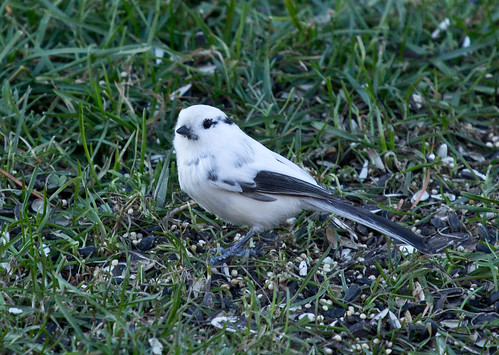 |
| Leucistic Black-capped Chickadee; photo Copyright 2019 by Gayle Friday |
On February 26, I received an email from Gayle Friday, who lives in Lakewood Township. She sent me three photos of a very odd Black-capped Chickadee. This bird was extremely pale in all the body areas where it would have any melanin—the cap was a light brownish-gray rather than black, the back lighter gray, the wings and tale extremely light gray, and the sides a very soft yellowish buff. I thought about the possibility that it could be a leucistic Boreal Chickadee, but the bright white on the cheeks is too extensive, and too precisely matching that of a black-cap.
 |
| Leucistic Black-capped Chickadee; photo Copyright 2019 by Gayle Friday |
|
Gayle wrote back with more details:
He first appeared on Feb 4 and what caught my eye was the white flash. He seems a bit larger than some of my other chickadees and they seem annoyed with him. His cap is lighter , kind of chestnut colored. He seems to like both suet and feeder but picks feeder over the suet. He is still coming daily. I live in Lakewood on 10 acres of mostly spruce pine aspen with some hardwoods. He is still visiting daily.
 |
| Leucistic Black-capped Chickadee; photo Copyright 2019 by Gayle Friday |
|
Any bird with lighter than normal plumage or unusual white areas on the body is called
leucistic. This chickadee is the first one I’ve ever seen that was in what might be called
dilute plumage—the definition of the word leucistic as I learned it in ornithology classes in the 1970s. I’ve seen several other leucistic chickadees over the years, but they were what I’d prefer to call partial albinos—parts of their bodies were normally colored while other parts were pure white.
 |
| I took this photo in Brimson, MN, some time in 2006. |
 |
| I photographed this one in Esko, MN, on November 8, 2012. |
The word
albino is now used in ornithology only to refer to a bird that is genetically incapable of producing any pigments, so it would have pink eyes and pink or dull tan legs and beak. And now the term “partial albino” is also out of favor, but in my opinion it’s rather useful to have two different terms to distinguish between patchy white birds and overall pale birds.
As rare as leucistic birds are, and as exceptionally rare as this particular leucistic bird is, I don’t feel the inner urgency to see it as I would if it were a Brambling or Fieldfare. Birding is rather an acquisitive endeavor, and what we mostly list are new species.
Matt Mendenhall,
BirdWatching magazine’s editor, wrote about the gynandromorph cardinal in Erie, Pennsylvania, under the headline, "Half-male, half-female cardinal is cool, but it's not drawing a crowd." Because gynandromorphism is a plumage condition even rarer than leucism, he wondered why a bird that had been so prominent in the media has been so ignored by birders, at least as far as going to Erie to see it. He writes:
I checked the Pennsylvania and Ohio birding listervs and did not find a single notice from members about this bird. No one posted directions to the yard, or additional photos, or tips for when to go.
If the Caldwells were hosting a Calliope Hummingbird, Black-headed Grosbeak, or some other vagrant from thousands of miles away, you can bet they would be enjoying the company of many, many strangers toting thousands of dollars worth of optics. They would all, with good reason, be trying to add the wayward bird to their life lists — and a large percentage would be shooting photo after photo of the visitor.
But no birder would travel to Erie or anywhere else to add Cardinalis cardinalis to their life list. Nor do I know anyone who keeps a list of gynandromorphs they’ve seen.
I actually do keep a list of the gynandromorphs I’ve seen, or I would except that I’ve only ever seen the one back in 1986. I’ll be trying to head to Gayle’s sometime this week to photograph her bird, to add images of it to my small collection leucistic chickadee photos. I hope her little bird makes it through this long, hard winter and many, many days to come.





